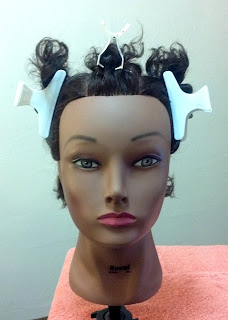“Are you sure?” the stylist asked … and then, “Are you sure you're sure?”
“Chop it down,” I said, "Have at it."
I'd spent what felt like a century with hair winding down my back. Plus, I'd already lopped off a few inches just months before so it was just above BSL. I'd been having several variations on the same dream, where I looked into a mirror to see my short hair reflected back. I awakened from these dreams smiling. I knew it was time.
I shampooed my hair the night before the appointment. So after she did some initial dry cutting, the stylist wet it down and finger-combed it, using DevaCurl Heaven in Hair, which doubled as a conditioner and styler. She set me under the hood dryer for a while then shaped my cut a little more. It wasn't her fault that I ended up with shorter hair than what I'd anticipated. She kept asking if I wanted more taken off, and I kept telling her yeah, drunk on the idea that the more hair she took off, the easier my overall hair care routine would be. (That turned out to be mostly true.) But some of the time I think she kept cutting because she was aiming for precision. Even though I showed her pics of my desired cut, cutting an (angled) inverted bob can be tricky on very curly hair. She did a good job.
I'm pretty happy with going short. Here are a few pics of my cut. They were taken a couple days afterward. I hadn't washed or re-styled it, which explains some of the disheveled pieces and some of the frizz (but really my hair tends to frizz anyway).
This pic taught me just how dirty the bottom of my mirror was, plus I inadvertently included the garbage can. Classy, huh? Haha
|
Hard to tell it's an inverted bob from this front view. Arm got "cut off" cause I was in a hurry to take this & the next pic :0
|
Hopefully those straggly, rogue pieces on the right side add spice to the mix.
|
... What's most surprising is how many styles I'm able to create with this short cut. I may post some of those styles in one of my next blogs. Thanks for stopping by!













.jpg)

















